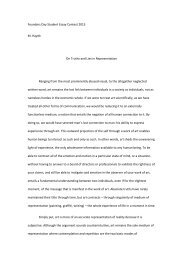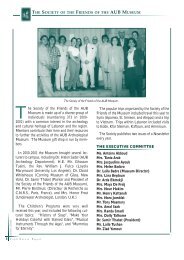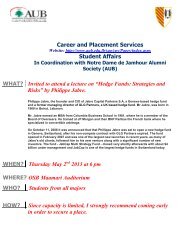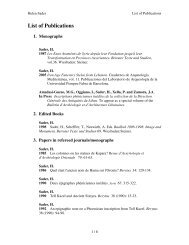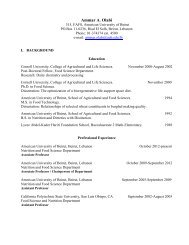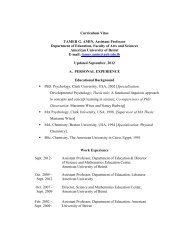The IX t h Makassed Medical Congress - American University of Beirut
The IX t h Makassed Medical Congress - American University of Beirut
The IX t h Makassed Medical Congress - American University of Beirut
You also want an ePaper? Increase the reach of your titles
YUMPU automatically turns print PDFs into web optimized ePapers that Google loves.
T h e I X t h M a k a s e d M e d i c a l C o n g r e s s<br />
ROLE OF ECHOCARDIOGRAPHY IN CARDIAC RESYNCHRONIZATION THERAPY<br />
Elie Chammas MD, FESC<br />
Cardiac resynchronization therapy (CRT) with biventricular pacing, is now recommended for<br />
patients with heart failure (Ejection fraction < 35%), under maximal therapy with wide QRS (> 130<br />
ms). After implantation <strong>of</strong> a CRT device, one third <strong>of</strong> the patients remain symptomatic without<br />
any improvement. <strong>The</strong> presence <strong>of</strong> mechanical dysynchrony is one <strong>of</strong> the possible causes.<br />
Cardiac echography is a powerful tool to detect mechanical dysynchrony by analyzing the<br />
interventricular, the intra ventricular and the auriculo ventricular delays. With the new technologies<br />
(Tissue synchronization imaging, 2D and 3D strain…), the echocardiography diagnosis <strong>of</strong><br />
mechanical dysynchrony became more accurate, Despite these techniques, the clinical data<br />
still disappointed. One <strong>of</strong> the explanations is the complexity <strong>of</strong> cardiac mechanics which can not<br />
be explored by one technique, another is the position <strong>of</strong> the pace maker leads.<br />
During this presentation, all the echo techniques to detect dysynchrony will be presented with<br />
the clinical data recently published.<br />
SHOULD WE EXPAND CRT TO MILD HEART FAILURE?<br />
Samer Nasr, MD<br />
Cardiac resynchronization therapy has become an established therapy for ischemic and non<br />
ischemic cardiomyopathies, with QRS widening. <strong>The</strong> effects <strong>of</strong> biventricular pacing were shown<br />
to have hemodynamic and non hemodynamic positive influence on myocardial function and<br />
increase in effectiveness <strong>of</strong> LV contraction with decrease in mitral regurgitation. Pathology studies<br />
have also shown Changes in myocytes and surrounding fibrotic changes similar to the changes<br />
seen with ACE inhibitions.<br />
<strong>The</strong> initial target <strong>of</strong> cardiac resynchronization therapy was to alleviate symptoms. This is confirmed<br />
by the design <strong>of</strong> the main trials that included improvement in NYHA class, and six minute walk test<br />
and measurement <strong>of</strong> quality <strong>of</strong> life using the Minesota quality <strong>of</strong> life score.<br />
With the success <strong>of</strong> the positive main initial came the AHA/ACC and ESC guidelines that we know<br />
recommended cardiac resynchronization trials in NYHA class two, three, and ambulatory four.<br />
<strong>The</strong> group <strong>of</strong> paucisymtomatic patients with severe left ventricular dysfunction and NYHA class<br />
one were left to be candidates for defibrillator implantation and not for biventricular pacing.<br />
<strong>The</strong> sole purpose <strong>of</strong> the therapy in this group <strong>of</strong> patients, was the prevention <strong>of</strong> sudden cardiac<br />
arrhythmic death. <strong>The</strong> common thinking was to implant a defibrillator and upgrade to biventricular<br />
pacing only if the patients worsen clinically and start showing signs and symptoms <strong>of</strong> salt and<br />
water retention.<br />
With growing experience it was left that many symptomatic patients with severe left ventricular<br />
dysfunction and QRS widening worsened rapidly with time. Recent large clinical trials have<br />
addressed this specific issue.<br />
Not surprisingly the benefits <strong>of</strong> CRT proved to be as good as in the symptomatic patients. We<br />
will go over the latest evidence covering the topic with emphasis on survival benefits and<br />
pathophysiologic data available to us at this time.<br />
78






